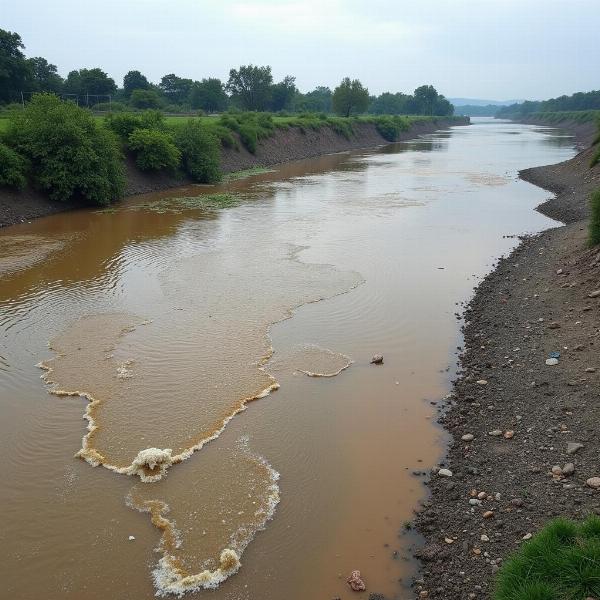Understanding the meaning of “sewage” in Hindi is crucial for effective communication about sanitation and public health in India. While a direct, single-word translation doesn’t fully capture the nuances of the term, several Hindi words and phrases convey the concept. This article explores the different ways to express “sewage” in Hindi, delving into related vocabulary and cultural context.
Different Ways to Say “Sewage” in Hindi
The most common Hindi word for sewage is मलजल (maljal). This term combines “mal” (waste) and “jal” (water), literally meaning “wastewater.” It accurately represents the mixture of wastewater and excrement that constitutes sewage. Another commonly used term is गंदा पानी (ganda pani), which translates to “dirty water.” While less specific than maljal, ganda pani is widely understood to refer to sewage, especially in informal conversations.
A more technical term for sewage is वाहित मल (vahit mal), meaning “carried waste.” This term is often used in official contexts and emphasizes the transportation aspect of sewage systems. Other related terms include अपशिष्ट जल (apshiṣṭ jal), meaning “wastewater,” and मल निकासी (mal nikasi), referring to “sewage disposal.”
Understanding the Cultural Context of Sewage in India
The concept of sewage and sanitation is deeply intertwined with cultural and religious beliefs in India. Historically, traditional systems emphasized natural processes and community-based solutions. However, rapid urbanization and population growth have strained existing infrastructure, highlighting the need for modern sewage management systems.
The Importance of Proper Sewage Management
Effective sewage management is essential for public health, environmental protection, and sustainable development. Untreated sewage poses significant risks, including waterborne diseases, pollution of water resources, and soil contamination. Investing in modern sewage treatment plants and promoting hygienic practices are crucial steps towards a healthier and cleaner India.
Sewage Treatment and Disposal Methods
Various methods are employed for sewage treatment and disposal, ranging from traditional septic tanks to advanced technologies like activated sludge process and membrane bioreactors. The choice of method depends on factors like population density, available resources, and environmental regulations. Promoting awareness about these methods and their importance is crucial for community participation in sewage management.
What are the Health Risks Associated with Untreated Sewage?
Exposure to untreated sewage can lead to a range of health problems, including cholera, typhoid, dysentery, and other waterborne illnesses. These diseases can be particularly dangerous for children and individuals with weakened immune systems.
 Impact of Untreated Sewage on Water Bodies
Impact of Untreated Sewage on Water Bodies
Conclusion
Understanding the meaning of “sewage” in Hindi and the associated vocabulary is vital for effective communication about sanitation issues. By using appropriate terminology and raising awareness about the importance of proper sewage management, we can contribute to a cleaner and healthier India. From the common term maljal to the more technical vahit mal, each word offers a nuanced understanding of this crucial aspect of public health. Investing in sustainable sewage systems and promoting hygienic practices are essential steps towards a brighter future.
FAQ
-
What is the most common Hindi word for sewage? The most common Hindi word for sewage is मलजल (maljal).
-
What are the health risks of untreated sewage? Untreated sewage can cause waterborne diseases like cholera, typhoid, and dysentery.
-
Why is proper sewage management important? Proper sewage management is crucial for public health, environmental protection, and sustainable development.
-
What are some methods of sewage treatment? Sewage treatment methods include septic tanks, activated sludge process, and membrane bioreactors.
-
What does ganda pani mean? Ganda pani means “dirty water” and is often used informally to refer to sewage.
-
What is vahit mal? Vahit mal means “carried waste” and is a more technical term for sewage.
-
What is the importance of understanding sewage terminology in Hindi? Understanding sewage terminology in Hindi is crucial for effective communication and raising awareness about sanitation in India.
Related Articles
Meaning-Hindi.in is your trusted partner for professional Hindi translation services. We specialize in various translation domains, including business and commercial documents, legal and certified translations, technical manuals, website localization, educational and academic materials, and express translation services. Our expert team ensures accurate and culturally sensitive translations to bridge the communication gap. Contact us today for high-quality Hindi translation services. Email: [email protected], Phone: +91 11-4502-7584. Get a free quote now at Meaning-Hindi.in.